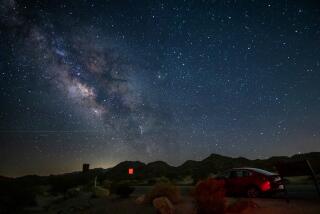Night Lights Linked to Babies’ Nearsightedness
- Share via
Infants who sleep in a room illuminated with night lights or full lighting are at substantially greater risk of becoming nearsighted than those who sleep in the dark, researchers from the University of Pennsylvania report in today’s Nature.
Nearsightedness, or myopia, is a growing problem: At least 25% of the U.S. population is myopic, and in some Asian countries, the prevalence is as high as 90%. In the disorder, the image of distant objects, focused by the cornea and lens of the eye, falls in front of the retina, leading to blurred vision.
Myopia is commonly caused by excessive growth of the eye during the months after birth, making it more elongated than normal. Studies in birds and monkeys suggest that this growth can be stimulated by a variety of environmental cues, including drugs and exposure to light during sleep periods.
The new study of 479 children “is an extension of myopia research in animals done by Dr. [Richard A.] Stone and others,” said Dr. Carl Kupfer, director of the National Eye Institute. “Additional studies are needed to determine whether eliminating such light exposure during sleep in early childhood can affect the development of [myopia],” he added.
But prudence would suggest that young children should sleep in the dark whenever possible, said Stone, the principal author of the study.
Others urged that the results be viewed with caution.
“We have to consider this preliminary, interesting and provocative, but I don’t think this proves the case yet,” said Dr. Arthur Rosenbaum, chief of pediatric ophthalmology at UCLA’s Jules Stein Eye Institute. “The numbers are impressive, but the findings are based on histories provided by parents, which are notoriously inaccurate.”
In the new study, Stone’s team enrolled 479 children between the ages of 2 and 16 at Children’s Hospital of Philadelphia. The parents of each child were questioned about the child’s exposure to light during the period from birth to age 2.
Of the 172 children who slept in darkness, only 10% developed nearsightedness. A total of 232 slept with night lights, and 34% of them became nearsighted.
Most troubling, of the 75 children who slept with a lamp or overhead light turned on in the room, 55% developed myopia--more than five times the percentage among those who slept in the dark.
Coauthor Dr. Graham E. Quinn of the Children’s Hospital noted that, “This was just a first pass at trying to understand if there is something here worth looking at. . . . The association [between light and myopia] came through rather strongly, and we need to do more research to find out why.
“We’re not sure why this happens, but it appears the eye needs a period of rest, just like the rest of the body,” Quinn said.
Critics of the study, such as Dr. Donald Mutti of UC Berkeley, were particularly concerned that the reported data did not include any information about the parents’ vision. Myopia has a strong genetic component: If the father is nearsighted, a child has a 40% chance of being nearsighted as well. If both parents are nearsighted, the child has a 60% chance.
The authors also did not take into account other sources of light, such as street lights shining through windows, critics said.
Quinn said that the researchers collected some data about parents’ vision and it did not change the results, but that the genetic link needs to be explored more thoroughly.
Ophthalmologists are concerned about myopia because its incidence seems to be increasing. The more urban a population is, the more industrialized it becomes and the higher the prevalence of myopia.
Some researchers have speculated that the rise is associated with increases in so-called near work--reading and other occupations where the worker must get close to the task. But no one is sure what is behind the rising incidence.
Nearsightedness can be corrected with glasses, but the condition can have long-term consequences. Later in life, nearsighted people are more likely to develop macular degeneration, detached retinas and other disorders that can lead to blindness.
“We’ve been worried about how the public would perceive this,” Quinn said. “People just have to be sensible about how they approach this. If the child [has medical problems] or is difficult to take care of, you may need to use a night light.
“But if he or she is asleep and happily snoring away, turn the light off. Kids under the age of 2 tend not to be frightened of the dark.”
(BEGIN TEXT OF INFOBOX / INFOGRAPHIC)
Lights Out
Pennsylvania researchers have discovered that infants who sleep in a room with a night light or with full lighting have a much higher risk of developing myopia, commonly called nearsightedness.





